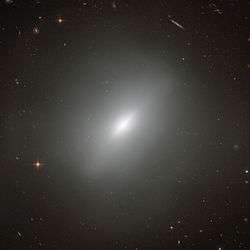NGC 3610
NGC 3610 is an elliptical galaxy in the constellation Ursa Major.[4] It was discovered on 8 April 1793 by William Herschel.[5]
| NGC 3610 | |
|---|---|
 Hubble Space Telescope image of NGC 3610, showing its disk | |
| Observation data (J2000 epoch) | |
| Constellation | Ursa Major |
| Right ascension | 11h 18m 25.276s[1] |
| Declination | +58° 47′ 10.49″[1] |
| Redshift | 0.005694[2] |
| Helio radial velocity | 1707[2] |
| Distance | 82.56 ± 29.32 Mly (25.313 ± 8.991 Mpc)[2] |
| Apparent magnitude (B) | 11.4[3] |
| Characteristics | |
| Type | E5:[2] |
| Size | 76,800 ly (23,560 pc)[2] |
| Apparent size (V) | 3.2′ × 3.2′[2] |
| Other designations | |
| UGC 6319, MGC+10-16-107, PGC 34566 | |
NGC 3610 was imaged by the Hubble Space Telescope in 2015. The image shows a prominent disk, a characteristic of spiral galaxies but not elliptical galaxies. Elliptical galaxies are thought to form from collisions with spiral galaxies; NGC 3610 is a relatively young elliptical galaxy which has still not lost its disk yet.[4]
References
- Skrutskie, M. (2006). "The Two Micron All Sky Survey (2MASS)". The Astronomical Journal. 131 (2): 1163–1183. Bibcode:2006AJ....131.1163S. doi:10.1086/498708.
- "Results for NGC 252". NASA/IPAC Extragalactic Database. Retrieved 12 February 2017.
- "NGC 3610". SIMBAD. Centre de données astronomiques de Strasbourg. Retrieved 12 February 2017.
- "A young elliptical". Hubble Space Telescope. Retrieved 16 December 2016.
- "NGC 3610 (= PGC 34566)". cseligman. Retrieved 12 February 2017.
This article is issued from Wikipedia. The text is licensed under Creative Commons - Attribution - Sharealike. Additional terms may apply for the media files.